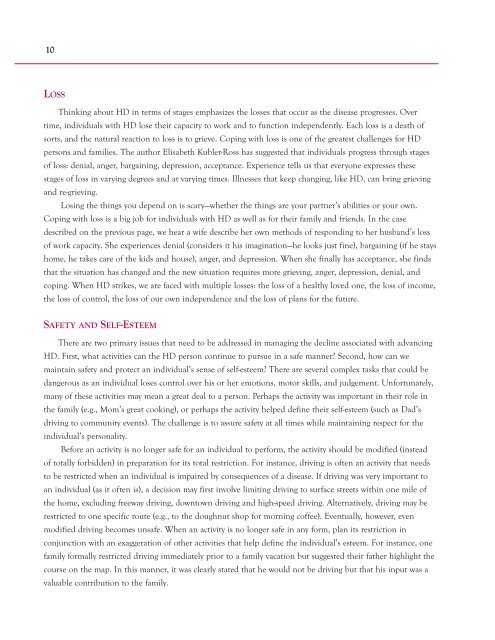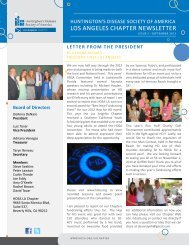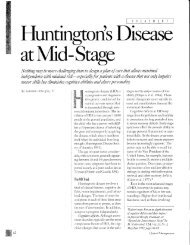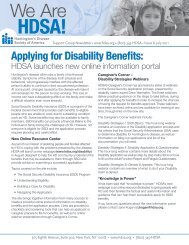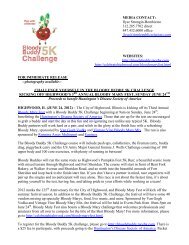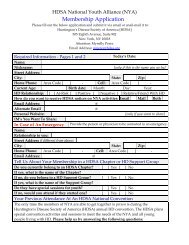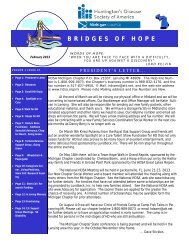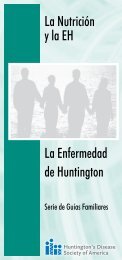Understanding Behavior in HD.final.8-18-05 - Huntington's Disease ...
Understanding Behavior in HD.final.8-18-05 - Huntington's Disease ...
Understanding Behavior in HD.final.8-18-05 - Huntington's Disease ...
You also want an ePaper? Increase the reach of your titles
YUMPU automatically turns print PDFs into web optimized ePapers that Google loves.
10<br />
LOSS<br />
Th<strong>in</strong>k<strong>in</strong>g about <strong>HD</strong> <strong>in</strong> terms of stages emphasizes the losses that occur as the disease progresses. Over<br />
time, <strong>in</strong>dividuals with <strong>HD</strong> lose their capacity to work and to function <strong>in</strong>dependently. Each loss is a death of<br />
sorts, and the natural reaction to loss is to grieve. Cop<strong>in</strong>g with loss is one of the greatest challenges for <strong>HD</strong><br />
persons and families. The author Elisabeth Kubler-Ross has suggested that <strong>in</strong>dividuals progress through stages<br />
of loss: denial, anger, barga<strong>in</strong><strong>in</strong>g, depression, acceptance. Experience tells us that everyone expresses these<br />
stages of loss <strong>in</strong> vary<strong>in</strong>g degrees and at vary<strong>in</strong>g times. Illnesses that keep chang<strong>in</strong>g, like <strong>HD</strong>, can br<strong>in</strong>g griev<strong>in</strong>g<br />
and re-griev<strong>in</strong>g.<br />
Los<strong>in</strong>g the th<strong>in</strong>gs you depend on is scary—whether the th<strong>in</strong>gs are your partner’s abilities or your own.<br />
Cop<strong>in</strong>g with loss is a big job for <strong>in</strong>dividuals with <strong>HD</strong> as well as for their family and friends. In the case<br />
described on the previous page, we hear a wife describe her own methods of respond<strong>in</strong>g to her husband’s loss<br />
of work capacity. She experiences denial (considers it his imag<strong>in</strong>ation—he looks just f<strong>in</strong>e), barga<strong>in</strong><strong>in</strong>g (if he stays<br />
home, he takes care of the kids and house), anger, and depression. When she f<strong>in</strong>ally has acceptance, she f<strong>in</strong>ds<br />
that the situation has changed and the new situation requires more griev<strong>in</strong>g, anger, depression, denial, and<br />
cop<strong>in</strong>g. When <strong>HD</strong> strikes, we are faced with multiple losses: the loss of a healthy loved one, the loss of <strong>in</strong>come,<br />
the loss of control, the loss of our own <strong>in</strong>dependence and the loss of plans for the future.<br />
SAFETY AND SELF-ESTEEM<br />
There are two primary issues that need to be addressed <strong>in</strong> manag<strong>in</strong>g the decl<strong>in</strong>e associated with advanc<strong>in</strong>g<br />
<strong>HD</strong>. First, what activities can the <strong>HD</strong> person cont<strong>in</strong>ue to pursue <strong>in</strong> a safe manner? Second, how can we<br />
ma<strong>in</strong>ta<strong>in</strong> safety and protect an <strong>in</strong>dividual’s sense of self-esteem? There are several complex tasks that could be<br />
dangerous as an <strong>in</strong>dividual loses control over his or her emotions, motor skills, and judgement. Unfortunately,<br />
many of these activities may mean a great deal to a person. Perhaps the activity was important <strong>in</strong> their role <strong>in</strong><br />
the family (e.g., Mom’s great cook<strong>in</strong>g), or perhaps the activity helped def<strong>in</strong>e their self-esteem (such as Dad’s<br />
driv<strong>in</strong>g to community events). The challenge is to assure safety at all times while ma<strong>in</strong>ta<strong>in</strong><strong>in</strong>g respect for the<br />
<strong>in</strong>dividual’s personality.<br />
Before an activity is no longer safe for an <strong>in</strong>dividual to perform, the activity should be modified (<strong>in</strong>stead<br />
of totally forbidden) <strong>in</strong> preparation for its total restriction. For <strong>in</strong>stance, driv<strong>in</strong>g is often an activity that needs<br />
to be restricted when an <strong>in</strong>dividual is impaired by consequences of a disease. If driv<strong>in</strong>g was very important to<br />
an <strong>in</strong>dividual (as it often is), a decision may first <strong>in</strong>volve limit<strong>in</strong>g driv<strong>in</strong>g to surface streets with<strong>in</strong> one mile of<br />
the home, exclud<strong>in</strong>g freeway driv<strong>in</strong>g, downtown driv<strong>in</strong>g and high-speed driv<strong>in</strong>g. Alternatively, driv<strong>in</strong>g may be<br />
restricted to one specific route (e.g., to the doughnut shop for morn<strong>in</strong>g coffee). Eventually, however, even<br />
modified driv<strong>in</strong>g becomes unsafe. When an activity is no longer safe <strong>in</strong> any form, plan its restriction <strong>in</strong><br />
conjunction with an exaggeration of other activities that help def<strong>in</strong>e the <strong>in</strong>dividual’s esteem. For <strong>in</strong>stance, one<br />
family formally restricted driv<strong>in</strong>g immediately prior to a family vacation but suggested their father highlight the<br />
course on the map. In this manner, it was clearly stated that he would not be driv<strong>in</strong>g but that his <strong>in</strong>put was a<br />
valuable contribution to the family.


